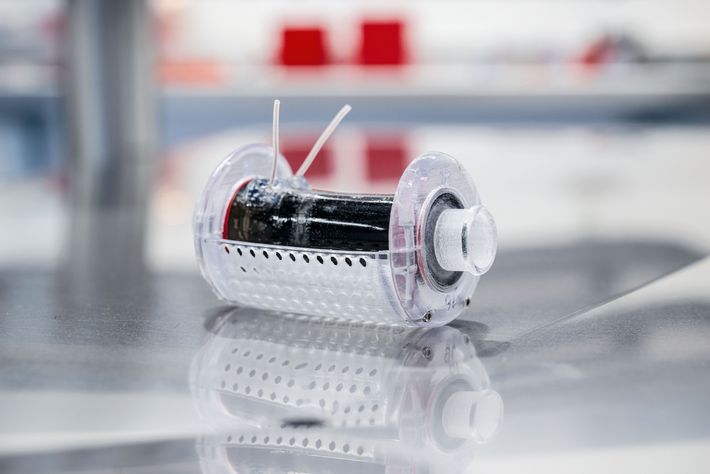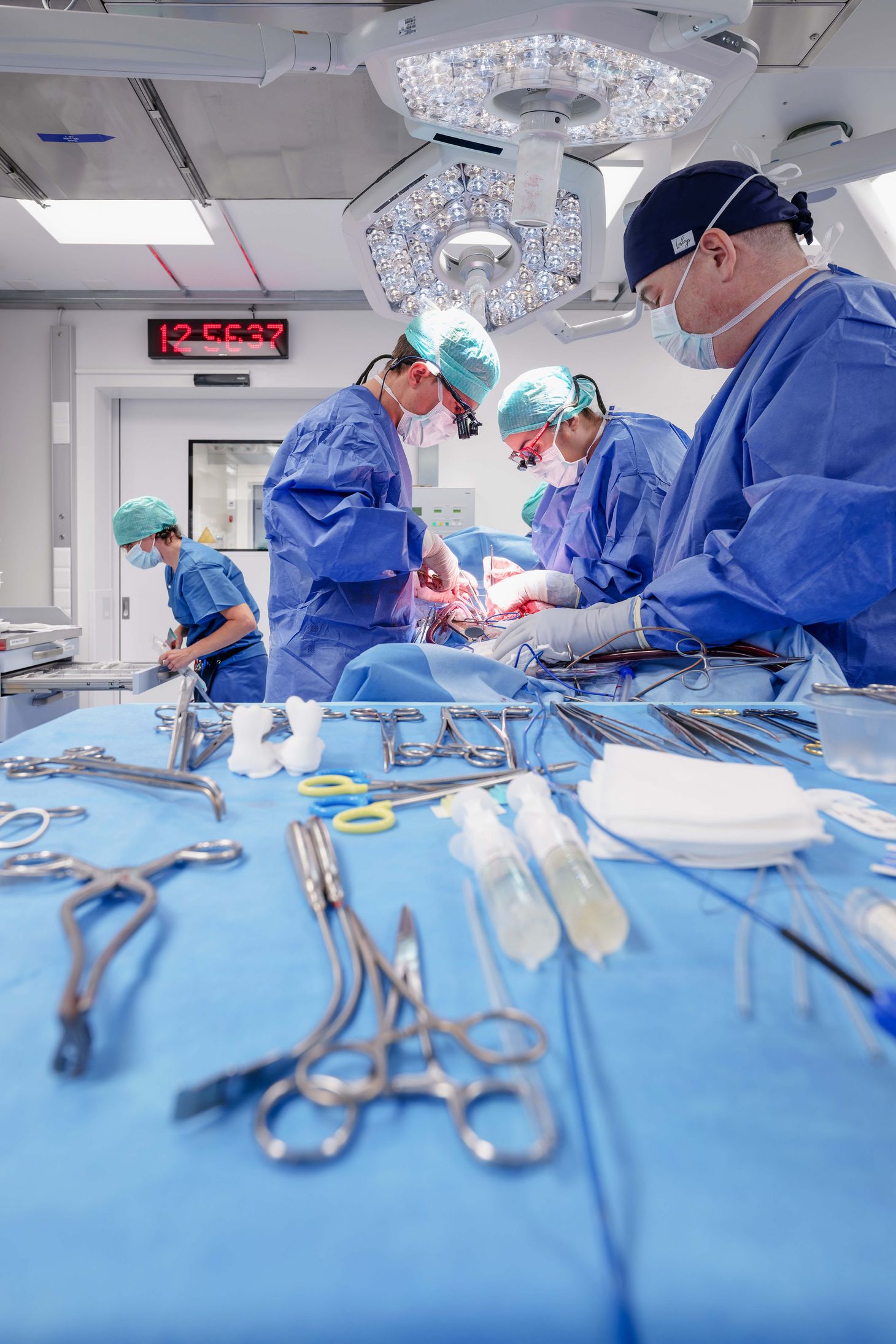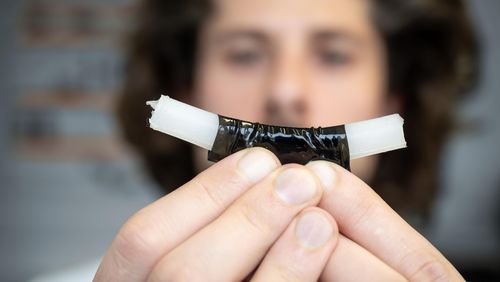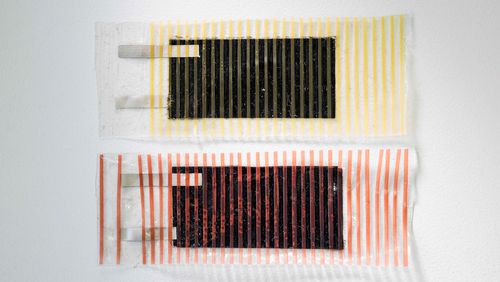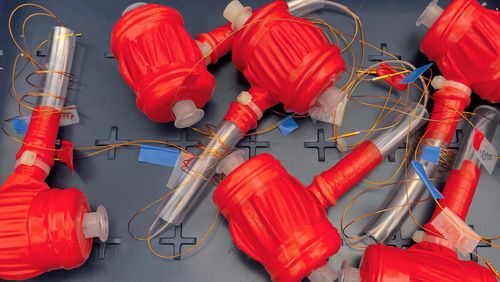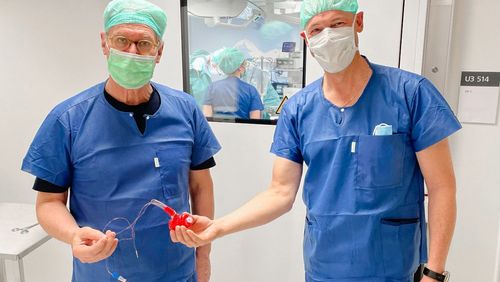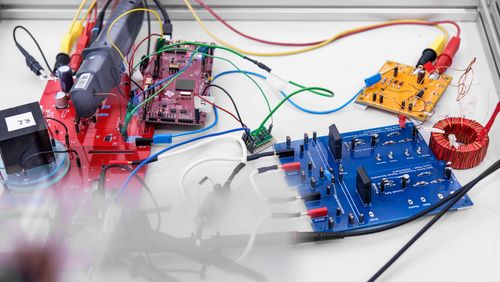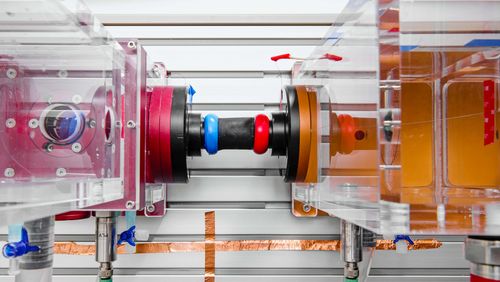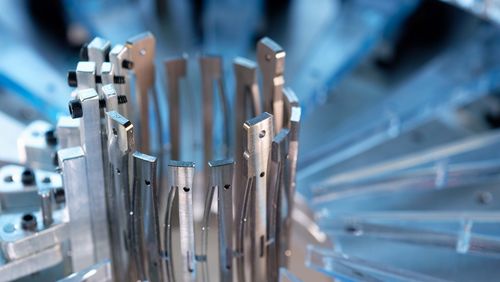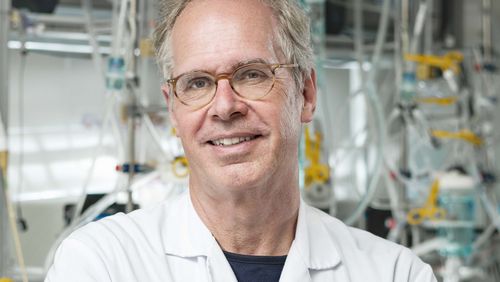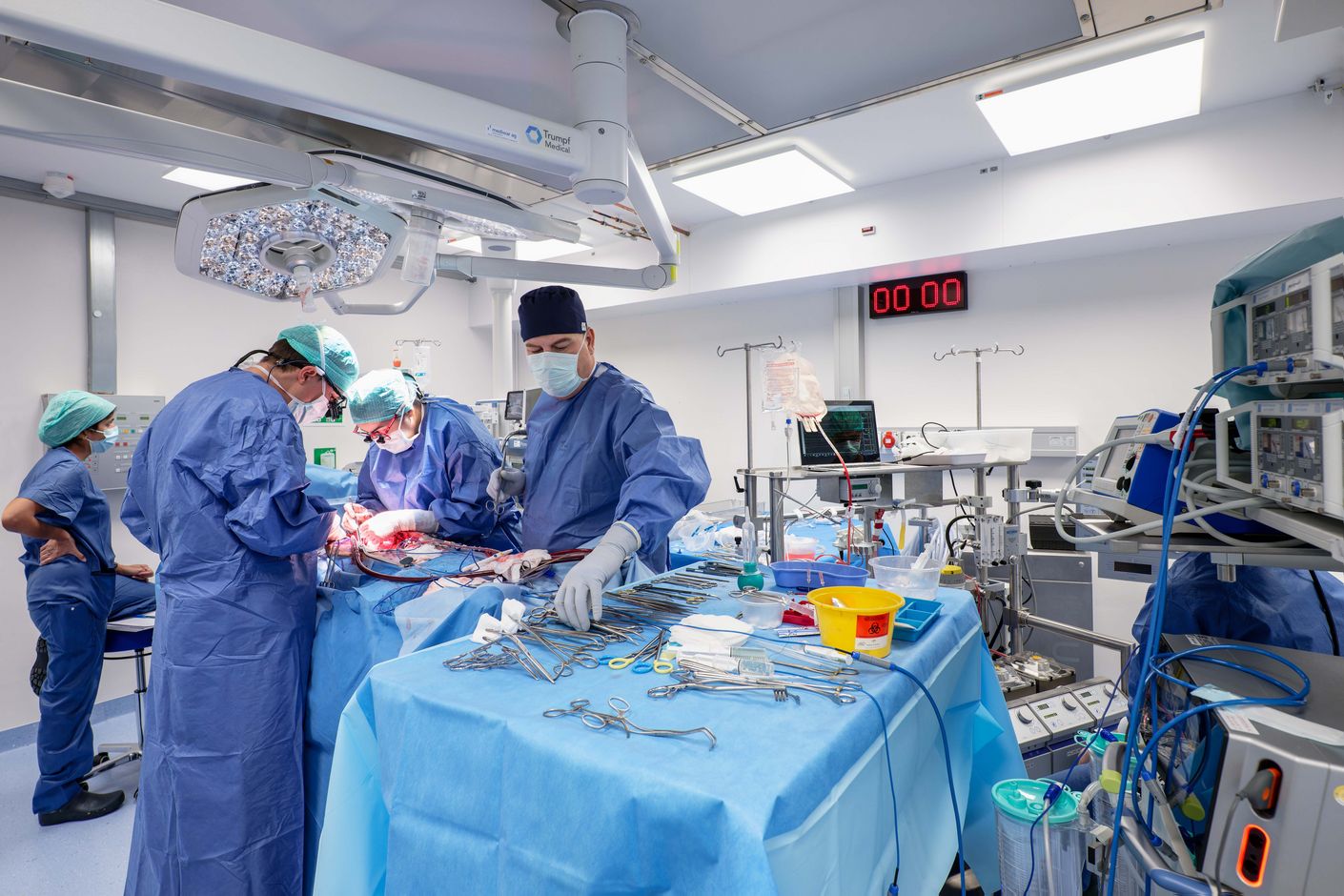
To the beat of a pig’s heart
An artificial muscle fitted around the aorta that gives weak hearts a boost—this is the ambitious goal of researchers at the Center for Artificial Muscles in Neuchâtel. To translate their research into practice, the team must first conduct animal research. In a hospital in Bern, they have recently tested a new version of their aorta ring on a pig.
The atmosphere in the small anteroom fluctuates between relaxed and highly focused. Half a dozen people are here in a lower level of Inselspital Bern, drinking coffee, working on their laptops and talking over their formulae, graphics and parameters. Yves Perriard, Yoan Civet and their team are waiting outside the operating theatre until it’s time for their part of the experiment. Although no one in the group is a medical doctor—they’re all microtech engineers—the team have launched a project that could write medical history.
With funding from the Werner Siemens Foundation, the researchers at the Center for Artificial Muscles (CAM) at the Neuchâtel campus of the École polytechnique fédérale de Lausanne (EPFL) are working on a world’s first: a soft, muscle-like ring designed to fit around the aorta of patients with weak hearts, thus ensuring that enough blood is pumped through the body. The development would be welcome: in Switzerland alone, more than two hundred thousand people suffer from cardiac insufficiency, a disease in which the heart’s pumping capacity can deteriorate to such an extent that it can no longer supply the body with enough blood and oxygen.
Invasive ventricular pumps
“The current solution is to implant ventricular pumps in patients with severe heart failure,” CAM director Yves Perriard says. But because ventricular pumps are mechanical devices made of rigid materials, invasive surgery is needed to insert them into the heart. “The pumps cause wear and tear on the heart lining, they can destroy red blood cells—and there’s a danger of blood clots forming,” Perriard continues. These problems could be avoided by using a soft artificial muscle that never comes into contact with the patient’s blood.
Today, the CAM engineers are testing an improved version of their artificial muscle prototype on a pig heart. The underground waiting room is part of the University of Bern’s “Experimental Surgery Facility”, a state-of-the-art animal testing facility encompassing two operating theatres so well equipped that surgery could be conducted on humans. For the past three hours, a team of doctors led by cardiac surgeon Paul Philipp Heinisch from Deutsches Herzzentrum in Munich have been in the operating theatre, implanting the aorta ring in the research animal.
Pliable—and taut
The ring consists of novel, highly elastic materials called dielectric elastomer actuators, which are formed by layers of an extremely pliant plastic (the elastomer) as well as layers of electrodes. When voltage is applied to the electrodes, an electric field arises between them, causing the opposing charges to be mutually attracted in accordance with Coulomb’s law. This is what enables the ring to expand and contract—depending on how much electric voltage is used.
A plastic tube protects the artificial muscle. “Otherwise, the muscle would be contaminated and functional failures could occur,” Perriard explains. In 2021, the team implanted this type of artificial muscle in pigs for the first time. “The principle proved effective, but the mechanical energy generated was still too weak to support the heart.” To increase pumping capacity, the researchers decided to build a new implant capable of withstanding a higher voltage. Perriard says the goal is for the artificial muscle to take over roughly twenty percent of the heart’s work.
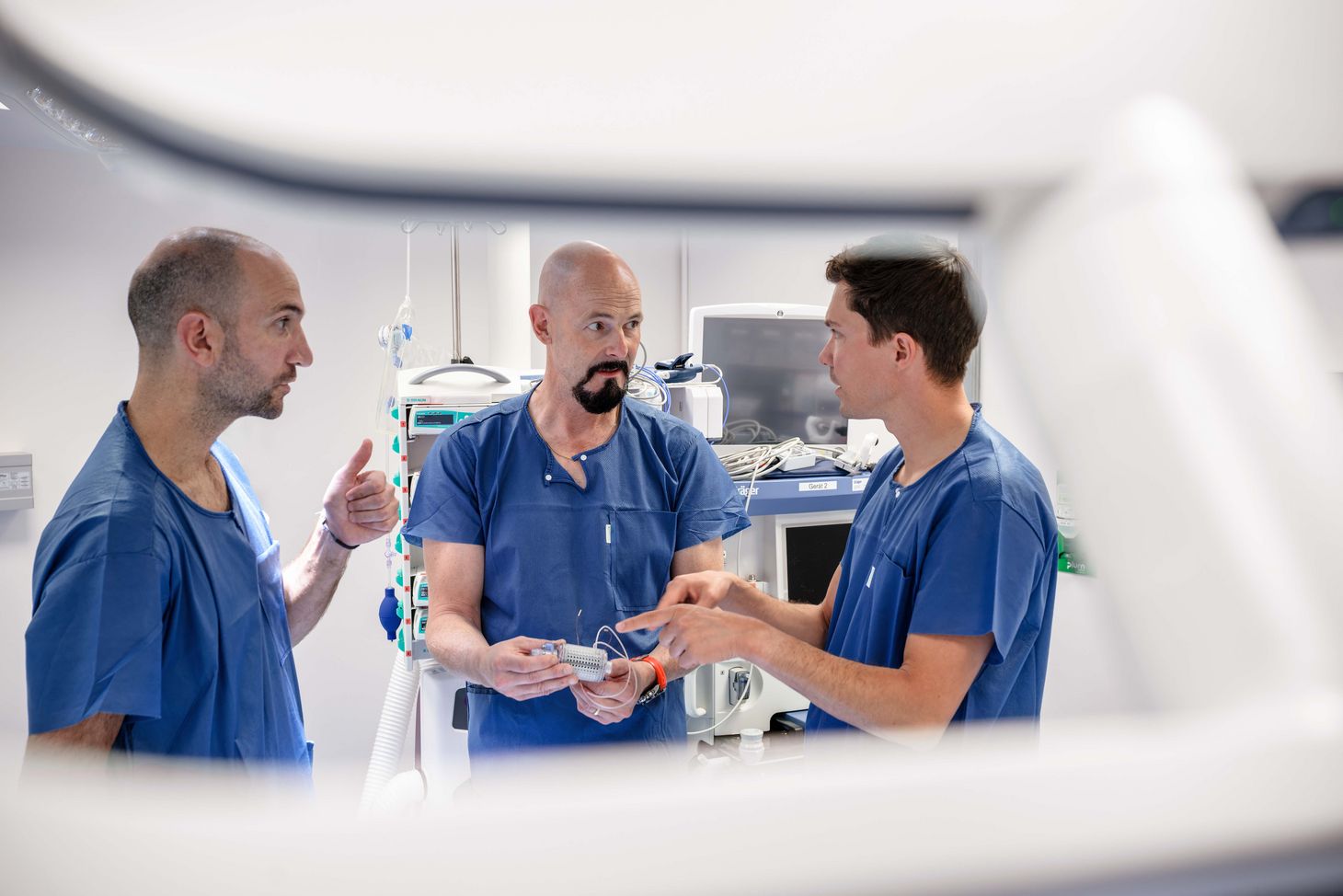
Complex synchronisation
The anteroom is suddenly filled with activity: the doctors have completed their work and are passing the baton to the microtech engineers. Two mobile tables laden with monitors, technical equipment and a multitude of cables are rolled into the operating theatre. Among the devices is a silver-coloured box: the pulse generator for the aorta ring. With an electric voltage of up to 6500 volts, its impulses are what cause the ring to dilate, then contract.
The biggest challenge facing the engineers is synchronising the movements of the artificial muscle with the natural heartbeat of the lab animal. “If they don’t synchronise, our device is useless,” says Yoan Civet, CAM managing director. What sounds simple, however, is highly complex. The researchers stare into their computer monitors, watching the waves depicting the rhythm of the heart and that of the ring. They attempt several synchronisations, but have to abort each effort. The pig’s heart rate starts fluctuating, and it keeps losing a beat.
Five-hour measurement session
The doctors also do what they can to get to grips with the problem—by adjusting the heart-lung machine connected to the lab animal’s circulatory system, for instance. Then, after a good hour of trial, error and recalibrations, the pig’s heartbeat is finally stable and the waves on the monitors are in synch. Now the microtech engineers can begin with their measurements: by applying electrical impulses of different strengths, they trigger the artificial muscle to make weaker and stronger movements. At the same time, their measurement instruments record blood pressure and blood flow in the ring, the aorta and the left ventricle.
For the duration of the surgery, the pig is put under a general anaesthetic; afterwards, it will be euthanised. Although the humane death in a research experiment is most likely much less stressful for the animal than ending up in the slaughterhouse, Yves Perriard is well aware of his responsibility towards the animals. “To obtain reliable results, we need to conduct animal experiments,” he says. “And because we can’t avoid them, we at least try to collect as much data as possible in each experiment.”
After roughly five hours of running tests on the aorta ring, Yves Perriard and Yoan Civet are pleased. “The monitors already show that our device changed blood flow and pressure,” says Perriard. “It’s a good sign.” However, the CAM team still need to perform comprehensive data analyses to obtain precise results. Only then will they know what the next steps should be—on their path to realising an entirely new treatment for patients with weak hearts.
